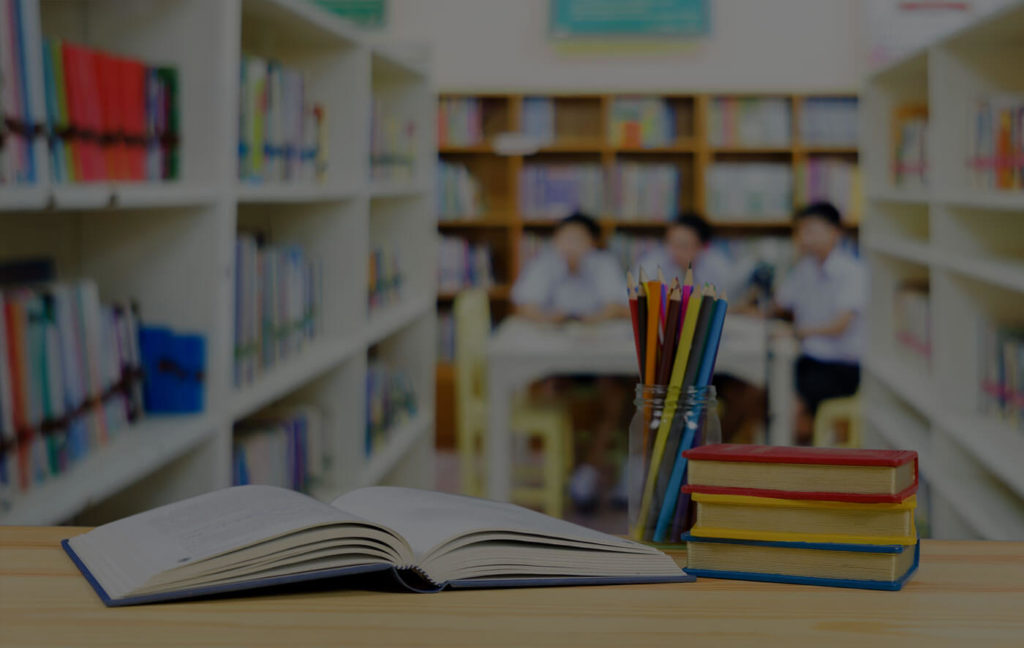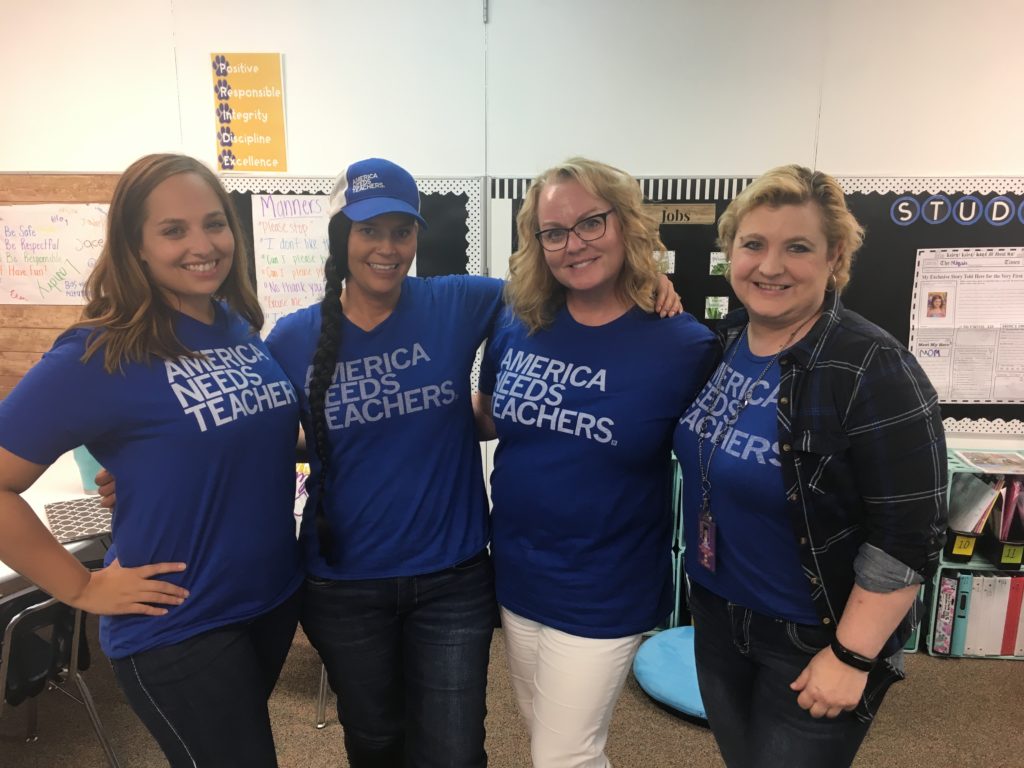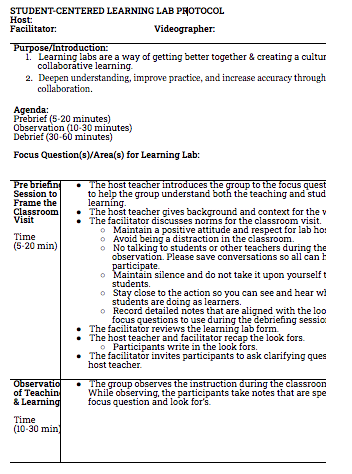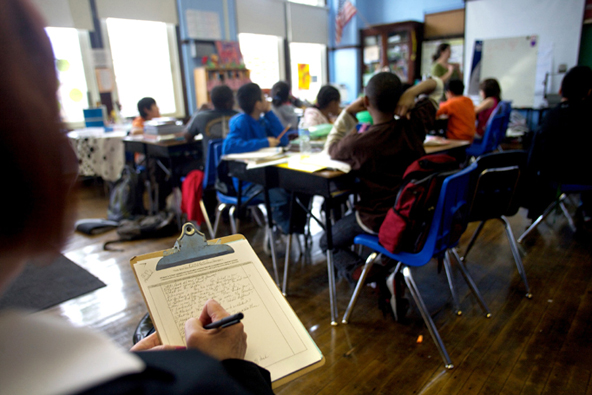Learning Labs are guided classroom visits with look fors and focus questions. They are led by classroom teachers and facilitated by an instructional coach. Learning Labs consist of a pre-brief, a classroom visit and a post-brief. Learning Labs are a way of getting better together, a chance to learn from one another and a chance to see your colleagues in action. Learning Labs are great for creating a culture of collaborative learning and are great for moving even the most resistant teachers along. Learning labs are a great way for teachers to learn from their colleagues. They also give teachers a visual model of new strategies.
Learning Lab Resources:
I LOVE Diane Sweeny and her student-centred coaching. I used the following resources to get started in conducting my first learning labs. Diane Sweeny Facilitating Coaching Labs.
We, as educators, are so confined to our own classrooms that we do not get to see the great things happening right next door or across the hall. The purpose of learning labs are to get teachers into other classrooms to learn from one another. To deepen understanding, improve practice, and increase accuracy through collaboration. Influence teachers to continually be willing to improve their teaching for the ever-higher achievement of students. Learning labs focus on a specific topic and are guided with specific focus questions and look fors designed by the facilitator.
Learning Lab Planning
To design a learning lab there are a few planning steps that need to happen before the learning lab can take place.
Step 1: Choose A Specific Focus

The first step of designing a learning lab is to find a specific focus based on the needs of teachers. Chose a focus based on something that other teachers need and could benefit from seeing in action. The key to finding a topic for a learning lab is to listen to teachers.
Learning Lab Topics:
Learning labs can be focused on any topic from classroom management to new instructional strategies. I have facilitated learning labs on classroom management, explicit teaching, co-teaching, student engagement, questioning, math centers, literacy structure (Daily 5), new curriculum, new district initiatives like SRG (standards-referenced grading) and PBL (project-based learning) and social-emotional learning. I am lucky to work with some pretty awesome rockstar teachers who are willing to step outside of the box and host learning labs, which may not be in their typical wheelhouse. The key in running a learning lab is to find those early adopters who are not afraid of inviting visitors into their classroom.
Step 2: Find A Host Teacher

The second step in designing a learning lab is to find a host teacher. This should be a teacher who will be a great model of the focus, who is willing to host a learning lab by allowing others to learn from them and is respected by their colleagues. Visit their classroom while they are implementing the learning lab focus to ensure the strategy is ready to model. This will help you in designing specific look fors and focus questions and give feedback to the host teacher.
Host Teacher Video:
I like to video the host teachers (with their permission) during this initial visit and meet with them to watch the video for reflection that same day. This is also the time to suggest improvements or tweaks if necessary and plan a time for the lab. This video will also be used in the learning lab promo that will be used to advertise for the learning lab. After the reflection, I ask the host teacher to video them summarizing the strategy they will see during the learning lab as well as to invite teachers into their classrooms.
Step 3: Advertise
The third step in designing a learning lab is to advertise. I like to create promo videos which include recordings of the strategy in action in the host teacher’s classroom. The promo video also includes an explanation of the strategy from the host teacher along with an invite from the teacher into their classroom. In addition, I include a summary of the learning lab protocol along with the exact times and dates the learning labs will be taking place along with the date and time of the post-brief reflection. Email the promo to all teachers who would benefit from attending the learning lab. In the email, I also ask that they email me back if they would like to attend so that I can get a count to prepare materials and figure out how many labs I would need to conduct.
Check out my YouTube channel for more ideas.
Note:
If there is a large interest, multiple learning lab options may need to be scheduled. I suggest keeping the learning labs small (5-7 visitors) so that there is minimal interruption within the classroom.
The learning lab may be targeted to specific teachers selected by the administration but I would suggest as an instructional coach to offer it to multiple teachers so that those targeted teachers don’t feel they are being singled out. The job of an instructional coach is non-evaluative. I would also advise that as a coach, stay out of any aspects of targeting or singling out any teacher. If the administration wants specific teachers to attend the learning lab, they should communicate with that teacher privately. As a coach, I don’t like to know if specific teachers are targeted for learning labs.
Step 4: Get Materials Ready
The fourth step in designing and organizing a learning lab is to get the materials ready. The teachers will use a learning lab recording form to record their observations on the focus questions and look fors. Make sure to keep the focus questions and look fors to a minimal. I suggest 1-4 look fors and 1-4 focus questions. During this step, I also find coverage for any teachers who need it in order to participate in the learning lab. Sometimes I have to get creative on this. If you are having difficulties, make sure to talk to the teacher who wants to attend, they will sometimes have a solution that you haven’t thought of. I would also suggest working with the administration on this part.

Click here for a link to my editable learning lab protocol.
Learning Lab Process
Pre-Brief:
I use the promo video as the first part of the pre-brief, which I send out a week before the learning lab will take place. Then, I Invite teachers to meet me outside of the classroom a few minutes before the lab is set to start. Next, I go over the look fors and focus questions that they will be looking for as well as the norms of the learning lab. This will prepare teachers to know what is expected of them in the classroom during the visit.
Learning Lab Norms:
Reminder to learning lab participants: During a learning lab, you are only going to get a snapshot of teachers and students in action. The goal is focusing on what you observe during a specific interval of time. All notes and reflections are confidential. Please record evidence and facts only based on the learning lab focus, keep opinions out of it and follow the norms below when you enter the classroom.
- Maintain a positive attitude and respect for lab host.
- Avoid being a distraction in the classroom.
- No talking to students or other teachers during the observation. Please save conversations so all can hear and participate.
- Maintain silence and do not take it upon yourself to teach students.
- Stay close to the action so you can see and hear what students are doing as learners.
- Record detailed notes that are aligned with the focus questions and look fors to use during the debriefing session.
Classroom Visit:
Once the pre-brief complete it’s time to visit the classroom. I give the learning lab participants a copy of the learning lab protocol with the norms, look fors and focus questions along with space to record observations along with a clipboard and writing tool if needed before we enter the classroom.

Post- Brief
This is one of the most important components of the learning lab. The group debriefs in the following rounds. Throughout each round, the facilitator ensures that the responses are specific and objective and do not include feedback or suggestions. Each round is done as a “whip-around” so that the discussion moves in an orderly fashion from one person to the next. Participants may pass when it is their turn to speak.
Round One: Student Evidence:
- What specific evidence did you see/hear regarding the focus question and look fors?
- “I saw . . .” or “I heard . . .”
Round Two: Implications
- Based on your observations, what are the broader implications for all students and instruction in general (not just in this classroom)?
- What does this mean for your teaching and learning?
Conversation Stems
- “Based on _____, I think _____”
- “Because I saw _____, I wonder if _____”
Round Three: Response from the Host Teacher
The host teacher responds by thinking aloud about the strategy modeled.
- How has the host teacher’s thinking changed?
- What is a future goal for instruction?
- How will student learning be assessed?
Conversation Stems
- “I feel… ”
- “From what I heard, I’m thinking…”
- “My next step would be…”
- “Student learning will be assessed by…”
Round Four: Next Steps for Participant Instruction and Support Needed
In a whip-around, each participant states the next step for his or her own work that arose from the observation. The facilitator takes notes for future follow-up and coaching.
- Next steps
- Takeaways
- New learning
- Aha moments that will influence your teaching within your own classroom
Conversation Stems
- “A goal I could set for myself is . . . “
- “One or two aspects from the observation that I could use in my instruction are . . .”
- “I realized my students . . . “
- “I would like to try . . . “
- “I need help with . . . “
Love this!! You’re amazing!!
Thanks Vicki!